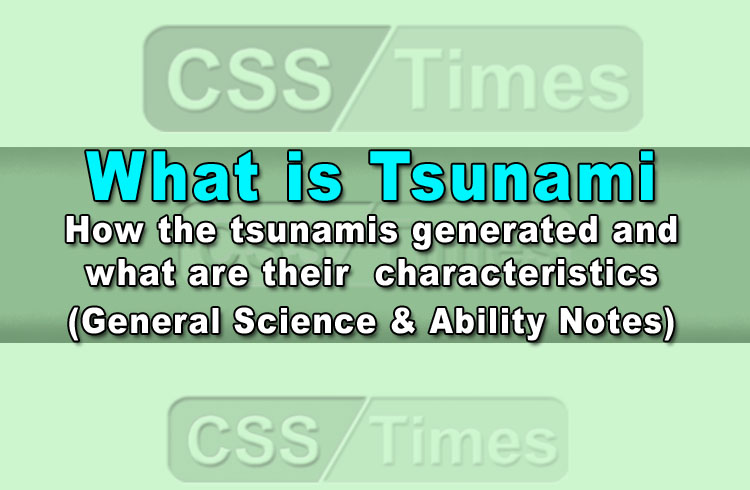Q: Describe different causes of Tsunami’. Is there any difference between a Tsunami and a tidal wave? Name the worst Tsunami ever recorded. (CSS-2018)
Q: What is tsunami? How the tsunamis generated and what are their characteristics? (CSS-2016)
What does “tsunami” mean? (CSS-2016/2018)
Tsunami is a Japanese word with the English translation, “harbor wave.” Represented by two characters, the top character, “tsu,” means harbor, while the bottom character, “nami,” means “wave.” In the past, tsunamis were sometimes referred to as “tidal waves” by the general public, and as “seismic sea waves” by the scientific community.
Characteristics (CSS-2018)
A tsunami can have wavelengths of 100 to 200 km, and may travel hundreds of kilometers across the deep ocean, reaching speed s of about 725 to 800 km/h. Upon entering shallow coastal waters, however, the waves may suddenly grow rapidly in height. When the waves reach the shore, they may be up to 30m high or more.
Tsunamis have tremendous force because of the great volume of water affected and the speed at which they travel. Just of water weighs >1 ton. Although the tsunami slows to a speed of about 48 km/h as it approaches a coastline, it has a destructive force equal to millions of tons. Tsunamis are capable of obliterating coastal settlements
Causes of Tsunami (CSS-2016/2018)
A tsunami is a series of large waves generated by an abrupt movement on the ocean floor that can result from an earthquake, an underwater landslide, a volcanic eruption or – very rarely – a large meteorite strike.
However, powerful undersea earthquakes are responsible for most tsunamis. Seismologists say only earthquakes measuring greater than 7.0 on the Richter scale can produce a major tsunami.
Most earthquakes that generate tsunamis – including Friday’s jolt off Japan’s eastern coast – occur in areas called subduction zones, where pieces of the Earth’s crust press against each other. Subduction means that one tectonic plate slides beneath another and sinks deep into the Earth’s mantle.
The friction between two slow-moving plates of the Earth’s crust creates vast amounts of seismic energy which is released in the form of an earthquake. When a strong undersea earthquake strikes a relatively short distance below the sea floor, it abruptly pushes up one of the immense plates of the Earth’s crust. That suddenly displaces an enormous amount of ocean water which becomes a tsunami, spreading outward in every direction from the epicenter of an earthquake – like ripples on a pond, only on a much larger scale.
Tsunamis generated in the open ocean appear to be only small waves, but they can grow rapidly in size as they reach shallow water before crashing into seacoast settlements. Waves up to nine meters high have been recorded on numerous occasions, and tsunamis up to 30 meters high are believed to have occurred in the past.
Damage is usually worst in areas closest to the undersea quake, often because the fast-moving waves will hit land so quickly. Tsunamis radiate out from the site of an undersea quake nearly as fast as a jet airliner can travel, but because the expanse of the Pacific is so wide, alert systems are in place to sound a warning to those in the path of an advancing wave.
Tsunami Warnings and Preparation
Tsunamis are rare and difficult to predict. Although scientists can rapidly detect an undersea earthquake through the use of seismometers, not all undersea earthquakes will generate a tsunami. Other factors, such as the topography of the ocean floor at the epicenter of a quake, are involved.
Major Disasters
The worst tsunami disaster in history occurred in December 2004 when a magnitude 9.0 undersea earthquake, centered in the Indian Ocean off the northwestern coast of the Indonesian island of Sumatra, generated a tsunami that struck the coasts of 14 countries from Southeast Asia to northeastern Africa. Almost a month after the disaster, the United States Geological Survey (USGS) reported a death toll of more than 150,000 people as a result of the tsunami and the earthquake, with nearly two-thirds of the deaths occurring in Indonesia. High death tolls were also reported in India, Sri Lanka, and Thailand.
The World’s 10 Deadliest Tsunamis (CSS-2018)
Indian Ocean (Sumatra, Indonesia)
Estimated Number of Deaths: 300,000
Year: 2004
Ancient Greece (Islands of Crete and Santorini)
Estimated Number of Deaths: 100,000
Year: 1645 B.C.
Messina, Italy
Estimated Number of Deaths: 80,000+
Year: 1908
Arica, Peru (now Chile)
Estimated Number of Deaths: 70,000 (in Peru and Chile)
Year: 1868
South China Sea (Taiwan)
Estimated Number of Deaths: 40,000
Year: 1782
Krakatoa, Indonesia
Estimated Number of Deaths: 36,000
Year: 1883
Nankaido, Japan
Estimated Number of Deaths: 31,000
Year: 1498
Tokaido-Nankaido, Japan
Estimated Number of Deaths: 30,000
Year: 1707
Hondo, Japan
Estimated Number of Deaths: 27,000
Year: 1826
Sanriku, Japan
Estimated Number of Deaths: 26,000
Year: 1896
Difference between Tidal Wave and Tsunami (CSS-2018)
A tidal wave is essentially a high tide that rises fast enough to appear in the form of a wave. It is solely affected by weather and the gravitational pull from the moon and sun. A tsunami, on the other hand, occurs when some event disturbs the ocean. They are usually caused by a geological event, such as an earthquake, volcanic eruption, or landslide.
Many consider tidal waves to be synonyms for tsunamis, however scientifically that is incorrect. In fact, tsunamis are not tidal at all. A tidal wave is essentially a high tide that rises fast enough to appear in the form of a wave. It is solely affected by weather and the gravitational pull from the moon and sun. Tides are the rise and fall of sea level that is caused by the gravitational pull of the moon and the sun on the Earth.
Tides are not only limited to the oceans, but can also occur in other systems, whenever a gravitational field is present. A majority of the Earth is affected by the gravitational force of the sun, though it is not as easily visible as it is on water. The moon has a more prominent affect on the tides, as it is much closer to the Earth compared to the sun. A wave can also be formed by wind blowing across the surface of the water. These waves are generally known as wind waves.
The term tidal wave is usually used to refer to unusual rise of water alongshore due to strong winds. They are most prominent in narrow bays or in rivers along the coast. The highest “tidal waves” are found in the Bay of Fundy, in the Canadian province of New Brunswick, where the water level can rise with the tide by 50 feet. Tidal waves may raise water level by several feet in just a matter of hours. However, it is also possible that a tidal wave will burn out before it reaches the coast. As a rule, tidal waves follow the currents and are unlikely to cause a landfall in areas of temperate climates or northern countries.
Check Other NOTES for General Science & Ability
- Science Myths Exposed: Unraveling the Truth Behind Them
- Science and its Branches
- Black Hole: What’s expected inside it? (CSS Paper 2007, 2018 Solution)
- Discuss the Function of Kidneys in Human Body (CSS Paper 2015 Solution)
- How solar eclipse and lunar eclipse are caused? (CSS Paper 2015 Solution)
- Different Branches of Science | General Science Notes
- Artificial Intelligence (AI) | CSS General Science & Ability Notes
- ‘Artificial Intelligence’ for humanity | General Science & Ability Notes
- What are Landslide and What Causes | General Science & Ability Notes
- Weather and Climate | General Science and Ability Notes







